A Bones system is a jointed, hierarchical linkage of bone objects that can be used to animate other objects or hierarchies.
Bones are especially useful for animating character models that have a continuous skin mesh. You can animate bones with forward or inverse kinematics. For inverse kinematics, bones can use any of the available IK solvers, or through interactive or applied IK.

Dinosaur character modeled using bones
Bones can be rendered, although this capability is off by default. They have several parameters, such as taper and fins, that can define the shape the bone represents. The fins make it easier to see how the bone is rotating.
For animation, it is very important that you understand the structure of a bone object. The bone's geometry is distinct from its link. Each link has a pivot point at its base. The bone can rotate about this pivot point. When you move a child bone, you are really rotating its parent bone.
It might be useful to think of bones as joints, because it is their pivot placements that matter, more than the actual bone geometry. Think of the geometry as a visual aid that is drawn lengthwise from the pivot point to the bone's child object. The child object is usually another bone.
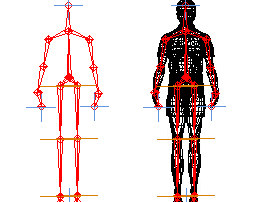
Bones system seen alone and inside a wireframe model
Any hierarchy can act as a bone structure (see To Use Objects as Bones). Simply turn on Bone On on the Bone Tools  Object Properties rollout.
Object Properties rollout.
Creating Bones
You start creating bones by clicking the Create Bones button on the Bone Editing Tools rollout, or by clicking the Bones button in the Systems category on the Create panel.
For details, see the topic To Use The Bones System in this section.
Assigning IK Controllers to Bones
By default, bones are not assigned inverse kinematics (IK). Assigning an IK solver can be done in one of two ways. Typically, you create a bone hierarchy, then manually assign an IK solver. This allows for very precise control over where IK chains are defined.
The other way to assign an IK solver is more automatic. When you create bones, choose IK solver from the list in the IK Chain Assignment rollout, and then turn on Assign To Children. When you exit bone creation, the chosen IK solver is automatically applied to the hierarchy. The solver extends from the first bone in the hierarchy to the last.
Setting the Initial Position of Bones
When you first create a bones system, the position of the bones is the initial state. Before you assign an IK solver or method, you can change the initial state of the bones by moving, rotating, or stretching individual bones.
Bone Color
By default, bones are assigned the color specified for Bones in the Colors panel of the Customize User Interface dialog. Choose Object as the Element and then choose Bones in the list. You can change the color of individual bones by selecting the bone, clicking the active color swatch next to the bone’s name in the Create panel or Modify panel, and then selecting a color with the Object Color dialog.
You can also assign bone colors and assign a color gradient to a bone hierarchy with the Bone Tools.
Bone Fins
Fins, available in Bone Tools, can help visualize bone orientation. You can also use them to approximate a character's shape. Bones can have up to three sets of fins: front, back, and sides, each its own Size and Taper settings. This feature is off by default.
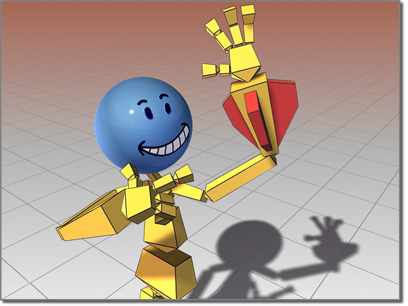
Bones can have fins.
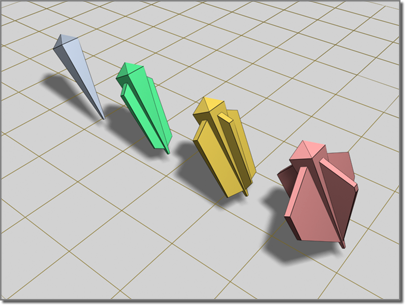
Bones with various fin configurations
Renderable Bones
While bones do not render by default, you can change that. To make a bone renderable, turn on its Renderable option in Object Properties.
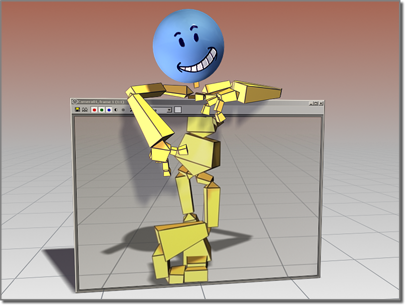
Bones can be renderable.
Object Properties for Bones
In addition to visual properties, bones have behavioral properties. The controls for these are included in the Bone Tools.
You can use these controls to turn other kinds of objects into bones.
Using Constraints with Bones
You can apply constraints to bones as long as an IK solver or method is not controlling the bones. If the bones have an assigned IK controller, you can constrain only the root of the hierarchy or chain. However, applying position controllers or constraints to a linked bone can cause undesirable effects, such as breaking of the bone chain.
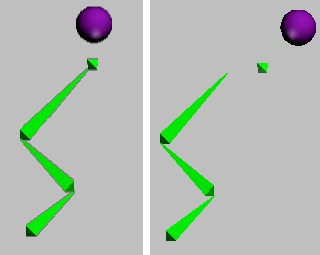
The “nub” bone at the end of the chain has a Spring controller applied to it. The Spring controller is connected to an animated sphere.
Right: The sphere's movement breaks the bone chain.
To avoid this problem, don't apply position controllers directly to child bones. Instead, create an IK chain and apply the controller to the IK chain's end effector.
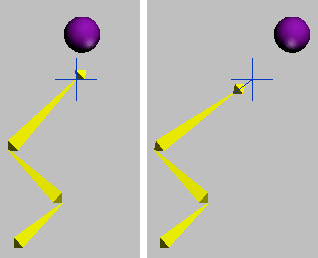
An IK chain has been applied, connecting the end nub to its parent bone. The IK chain's end effector is connected to the ball by a Spring controller.
Right: Now when the sphere moves, the IK chain prevents the bones from breaking.
Constraints and controllers that affect orientation only, such as Orientation or Look At, do not present this problem when applied to child bones.